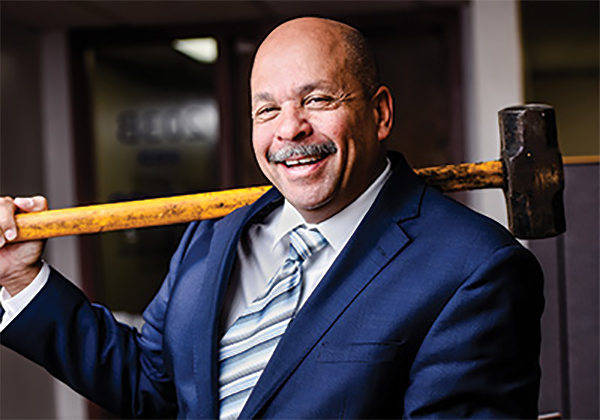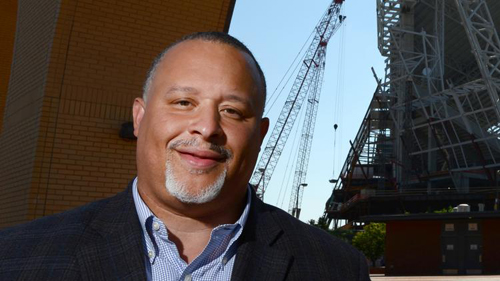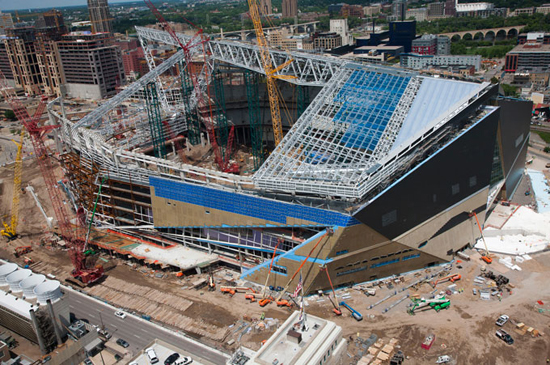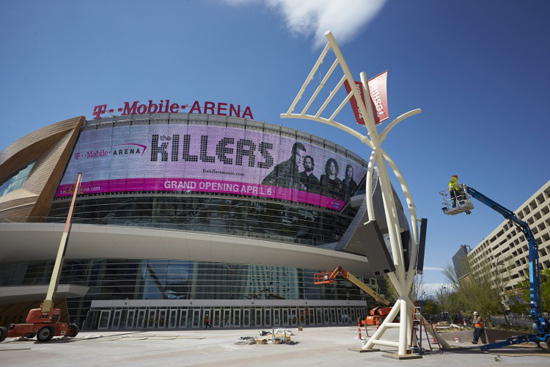Ray's article
The attack on Pearl Harbor in Hawaii on December 7, 1941,
would bring the United States into World War II, but it also raised a concern
that the U.S. Territory of Alaska was vulnerable to Japanese attack. The Aleutian
Islands off southwest Alaska were closer to Japan than any point in North
America. In the event of a Japanese invasion, the Alaska-Canada highway (ALCAN) would be
necessary to protect Alaska civilians.
Overland travel by car, truck, or train between the United
States and the Alaskan territory at that time was just not possible due to the
rugged topography, and Canada did not have an incentive to build a connecting
road through its territory north of Dawson Creek.
So, in 1942, President Franklin Roosevelt along with the
Canadian government authorized the construction of the Alaska-Canada Highway
(ALCAN) to connect Alaska to the continental United States.
Construction of the highway begin on March 8, 1942, but, in order
for this highway to prove effective, the speed in which it was constructed was
essential to the military’s needs; the Alaska-Canada Highway needed to be built
in 8 months’ time.
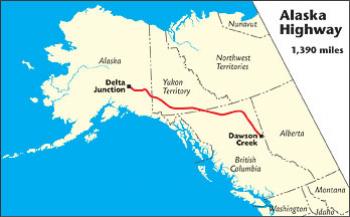
To complete this grueling highway in just 8 months, the U.S.
government hired private contractors and also commissioned the Army Corps of
Engineers. Due to World War II, many members of the Army Corps of Engineers
were in the South Pacific assisting with war efforts. This led to the need for
more manpower to complete the administration’s ambitious Alaska Highway
project. As a result, the War Department led by Colonel William M. Hoge, took
the historic step of deploying Black/African-American regiments of the Army Corps of
Engineers.

Approximately
5,000-7,000 of the initial 11,000 troops assembled to complete the highway and
install the companion Canol pipeline were Black. There were four regiments of
African-American engineers involved in building the Alaska-Canada Highway, the
93rd Engineer General Service Regiments, the 95th Engineer General
Service Regiments, the 97th Engineer General Service Regiment and the 388th
Engineer Battalion. Theirs were the first black regiments deployed outside the
lower 48 states during the war.
In the interest of speed, officials decided to build the
road in two phases. A pioneer road would be carved out of the difficult terrain
in 1942 to open the route for supply trucks by year's end. The U.S. Army Corps of Engineers was to build
the pioneer road, with Army engineering units and private contractors. Initially, the Army divided the 1,500-mile project into
five segments, with private contractors responsible for the portion from Whitehorse
to Big Delta, about 560 miles. But after proving to be a very difficult feat to
complete, the contractors work was extended by 100 miles to the east.
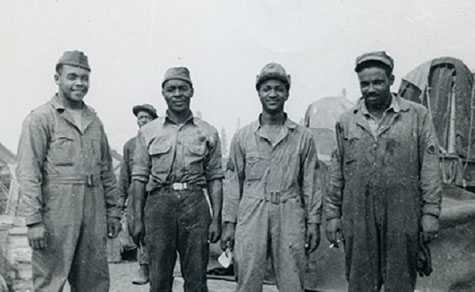
Since approval of the Selective Service Act of 1940, Black
American soldiers had been drafted into the Army on the same terms as whites,
but as Heath Twichell explained in his book on the Alaska Highway,
"Segregation's legacy of bigotry and prejudice severely limited the
possibilities" for the work they would do:
“As a result, relatively few black infantry, armor, or artillery
units were organized during World War II… In the end, black soldiers were assigned to
more than their share of units engaged in low-tech, high-sweat duties in the
Engineers and Quartermaster Corps. Although the Corps of Engineers put most of
its new black soldiers into general-purpose construction battalions and regiments,
shortages of heavy equipment sometimes resulted in the black units' being
issued fewer bulldozers and more shovels and wheelbarrows than the white units
got.”
Another touchy issue was where to station the new black
units. In the United States, military leaders felt they had to worry about the
impact of large numbers of young black soldiers on nearby civilian communities.”
[Northwest , p. 97-98]
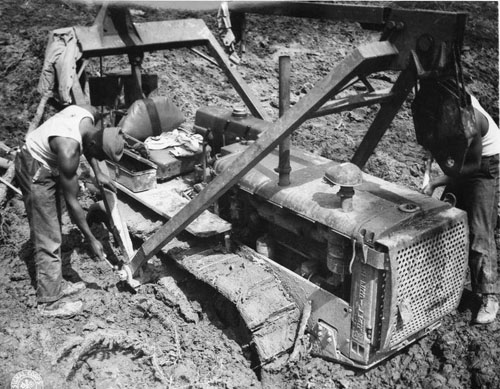
The enlisted men, most of them from the South, faced racial
discrimination from white officers. The black soldiers were barred from
entering any towns for fears from white soldiers that they would procreate a “mongrel”
race with local women.
During the construction of the highway, the black American
soldiers endured winter conditions they had never experienced before, including
record low temperatures, the temperatures ranged from 90 degrees above zero in
summer to 70 degrees below zero during the winter. The black troops also had to fight swamps,
rivers, ice and cold, whiles battling the segregation with in their own corp.
Jim Sutton, a white American soldier who had worked on the highway project
alongside the blacks stated:
"They were up here when we got up here. We were put in barracks, wooden barracks, and we had stoves and everything. These poor black people were doing the same job as we were and they had them in tents. I didn't think that was really fair."
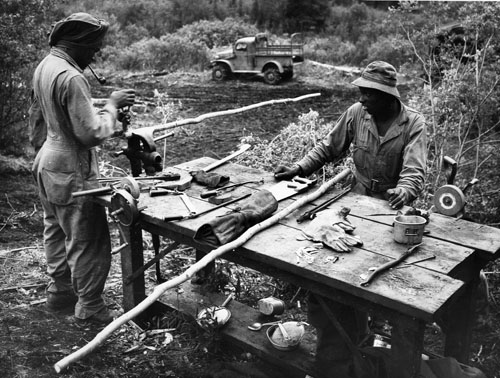
Housing wasn’t the only form of injustice the black soldiers
faced, but many times struggling through long difficult trips to reach the project
site with their equipment, the black American troops found that their best equipment
would be shifted to the white units.
Although, in practice the African-Americans were involved in many phases of construction, often never working with the white troops, but performed the more grueling labor intense work, while white troops sometimes less skilled, managed and directed. For this reason, many of the soldiers felt they were fighting two wars, one against the Axis (Japan, Germany and Italy) and a second against segregation.

After cutting an access road over Mentasta Pass from Slana
to Tok, the all black 97th Engineers battalion was used to perform the grueling work of speeding
the opening of the northernmost third of the Alaska Highway by helping the
private contractors and the 18th Engineers close the gap between Whitehorse and
Big Delta. Similarly, after opening a trail from Carcross to help the 340th
Engineers reach Teslin, another all black battalion of the 93rd Engineers
would start work on the pioneer road from that point toward Whitehorse, during
freezing conditions.

With private contractors and Army engineering units working on segments of the Alaska Highway, gaps began to close in August. By the end of September, only the most difficult sections, through eastern Alaska and the southwest corner of the Yukon, remained to be completed. [North to Alaska , p. 130]
The final gap was closed on October 29, 1942, south of Kluane Lake. Coates quoted Malcolm MacDonald, British high commissioner to Canada, on the final moments:
The final meeting between men working from the south and men working from the north was dramatic. They met head on in the forest. Corporal Refines Sims, Jr., a negro from Philadelphia [of the 97th Engineers] . . . was driving south with a bulldozer when he saw trees starting to topple over on him. Slamming his big vehicle into reverse he backed out just as another bulldozer driven by private Alfred Jalufka of Kennedy, Texas, broke through the underbrush. Jalufka had been forcing his bulldozer through the bush with such speed that his face was bloody from scratches of overhanging branches and limbs. That historic meeting between a negro corporal and white private on their respective bulldozers occurred 20 miles east of the Alaska-Yukon Boundary at a place called Beaver Creek. [North to Alaska , p, 130-131]

One of the greatest accomplishment of the black troops was Sikanni
Chief River Bridge. The Sikanni Chief River is a fast-moving river that is over
300 feet wide located about 162 miles outside of Dawson Creek, Canada. The
African-American engineers built the bridge without heavy equipment, utilizing
minimal supplies and in miserable conditions. They used hand tools, saws, and
axes to build the bridge in less than three days using lumber from nearby
trees.
During some phases of the bridges construction the black
troops had to plunge chest deep into the river’s freezing and rapidly moving
waters to set trestles. The soldiers used the headlights of trucks to keep
working at night while singing work chants and chain gang songs. Despite the
military still being segregated, after witnessing this amazing feat, Col. Heath Twichell Sr. ordered his white
officers to eat with the black enlisted men.

Over the years, as public attitudes changed, the
African-Americans who helped build the pioneer trail received recognition for
their accomplishment. Brinkley interviewed some of the veterans:
“They all talked to me about duty for country and reminisced about their harsh living conditions, tasteless food, and bitter winters where frostbite was their primary foe. Stories about wading chest deep into freezing lakes to erect bridge trestles or having a finger fall off when the temperature hit a record -70o F or lowering the coffin of a comrade into the cold ground conjured bleak memories of Jack London's most brutal tales like "To Build a Fire" or "Burning Sun." Snowdrifts were often twenty feet deep. "For months on end, I couldn't get a real night's sleep," one veteran recalled. "I had nightmares I was freezing to death." Although these black soldiers had at their disposal 11,107 pieces of equipment, trucks, tractors, crushers, graders, and bulldozers, breakdowns occurred hourly. The job was daunting. Never before, it seems, had so many survey sticks been hammered into the earth at a given time. To keep morale up they often chanted old southern work tunes like "Steel-Driving Song" and "Swing Low, Sweet Chariot." With brawn and courage and valor they persevered, completing the Alcan Highway in just over eight months, with the official opening on 21 November 1942. [Alcan , p. 10]

The African-American regiments that built the Alaska-Canada
Highway established a reputation for excellence especially in the field of
bridge building. However, their accomplishments were consistently ignored by
mainstream media and press. It took decades for them to receive proper
recognition for their achievements. Some say they were as “legendary” as the
Tuskegee Airmen and the Buffalo Soldiers.
Many people attribute the success of these African-American
engineers during the Alaska-Canada Highway project as one of the events that
led to eventual desegregation of the military in 1948. Some call the ALCAN
Highway the “Road to Civil Rights” for this reason.
After just over 8 months , the Alaska-Canada Highway (ALCAN)
was completed on November 21, 1942. The ALCAN highway project is still
considered one of the biggest and most difficult construction projects ever
completed by the US Army Corps of Engineers. It stretches 1,422 miles from
Dawson Creek, British Columbia in Canada to Big Delta, Alaska. The project cost
about $138 million dollars and was the most expensive World War II construction
project.
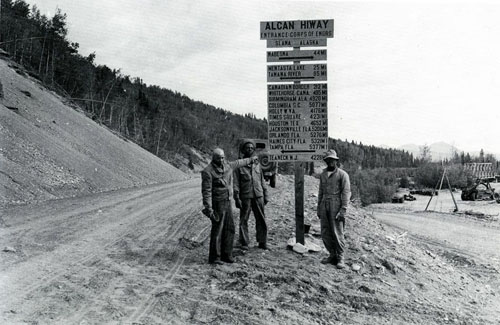
Approximately 30 men died during the Alaska-Canada Highway construction project. In 1992 there were over 2,000 different celebrations held to commemorate the highway's 50th anniversary, but none of them honored, and most hardly mentioned, the black units who represented one of the projects largest portions of manpower. James Eaton, curator of the Black Archives Research Center and Museum at Florida A&M University in Tallahassee, called the soldiers, "A lost page in history."
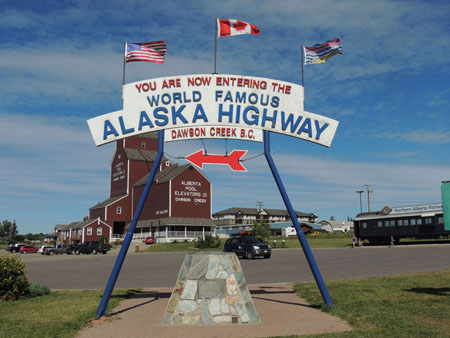
On July 4, 1992, the city of Anchorage, Alaska invited several of the veteran black troops from the corp. of engineers to participate in the city's parade down Main Street. Two of them, Albert E. France andDonald W. Nolan, Sr., were from Baltimore. France was a 75-year old retired railroad worker, while Nolan was a 72-year old retired postal worker, both recalled in a newspaper interview, the first thing they remembered from working on the Alaska-Canada Highway was the cold:
"It was awful
cold and it snowed for days," recalled Mr.France . . . . It was the
coldest winder on record in the territory.
"Leather would freeze," recalled Mr. Nolan . . . .
"We'd take galoshes, rubber galoshes - we called them 'Arctics' - and we'd
wear three, four pairs of socks we would double up on pants. We slept on the round
in pup tents."
“Food was never plentiful. C-rations, bittersweet chocolate
and "hardcracks" might be all a soldier would get to eat after the
harsh climate cut off supply routes.”
"We'd kill a bear, a huge black bear," said Mr.
Nolan,"about 9, 10 feet high, and those chops were delicious."
When the snow stopped, the rains started and the rivers swelled.
In summer, mosquitoes droned like airplanes and the "muskeg," a
uniquely Alaskan bog, swallowed tractors… In that barren landscape, the
off-work hours could seem exceptionally long.
Looking back, Nolan said he was glad to have served on the project. "You have something to tell your kids." [The Baltimore Sun , July 4, 1992]
Memorials for the black soldiers that helped in the competition
of the ALCAN Highway are scattered along
the highways 1,400 miles path. One of the most recognized memorials is the‘Black
Veterans Memorial Bridge’ which was dedicated in 1993 to the African-American
engineers who died during the construction project.
Congress in 2005 said that the wartime service of the four
regiments covered here contributed to the eventual desegregation of the Armed
Forces.
After four decades of operation, the largest black-owned construction company in the United States, THOR Construction companies, a Minneapolis-based contracting and management firm is shutting down, according to its founder & chairman, Richard Copeland.
After experiencing explosive growth over the last 2 years, THOR construction company will be ending operations. THOR in 2017 had revenues of $368 million, up 162% from $140 million in 2016. According to THOR, just under $197 million came from the acquisition of JIT Energy Services, a minority-owned energy management and utility cost reduction services firm, for an undisclosed amount.
This year, THOR Companies reportedly begin to revamp its
business model in an attempt to overcome some financial challenges. In this
effort, THOR hired Manchester Cos. as its chief reorganization officer, as it
worked to salvage its financial affair. Manchester, which is also based in
Minneapolis, is known for turning around and restructuring companies.
However, in January of 2019, Sunrise Banks sued THOR and its
founder and chairman Richard Copeland, pursuing restitution exceeding $3
million. The bank requested that a receiver be appointed to take control of
THOR, according to a lawsuit filed in Hennepin District County Court in
Minnesota.
The St. Paul, Minnesota, Sunrise bank claimed that THOR “is
generally not paying its debts as they become due, including payroll
obligations to its employees and its debts to Lender. As a result of this
lawsuit, multiple creditors will likely attempt to engage in a ‘free-for-all
liquidation’ of THOR construction Co.
Although, according to Copeland, “THOR has never missed a
payroll in 40 years to date. We have several companies rallying around this effort;
however, the bank has done everything in its power to put us in receivership.”
In law, receivership is a situation in which an institution
or enterprise is held by a receiver—a person "placed in the custodial
responsibility for the property of others, including tangible and intangible
assets and rights"—especially in cases where a company cannot meet
financial obligations or enters bankruptcy.
In an interview with the Star Tribune in Minneapolis a few
months ago, Copleland said: “We’ve struggled in a tough industry with some of
the best contractors in the world as our competition. We cobbled along for 40
years and never had anything like this happen. We hope to attract new money and
are poised with good customers to do well.”
“We have had a credit line with Sunrise Bank for 11 years.
The LOC [line of credit] was to expire on 12-31-18. The LOC was as high as $5.8
million, but over the last two years, we had reduced the line by $2.8 million
down to $3 million. We also believe that almost half of the $3 million line
remaining, that $1.3 million of it were not legitimate,” Copeland said in an
interview with Black Enterprise magazine.
Yet, as if things couldn’t get worst, in February of this year THOR’s CEO, Ravi Norman (pictured above), stepped down from the company. Norman told the Minnesota publication ‘Finance & Commerce’ that he is no longer an employee at THOR. Norman worked at THOR for several years, serving in CEO and CFO roles at the business.
The closure of THOR construction Co. comes after THOR
celebrated the opening of a new headquarters, a $36 million office/retail
building in north Minneapolis in September of 2018.
THOR Cos. Co was a model contractor admired not only by
other black-owned companies, but by most major contractors for its performance,
and will be greatly missed in the construction industry.
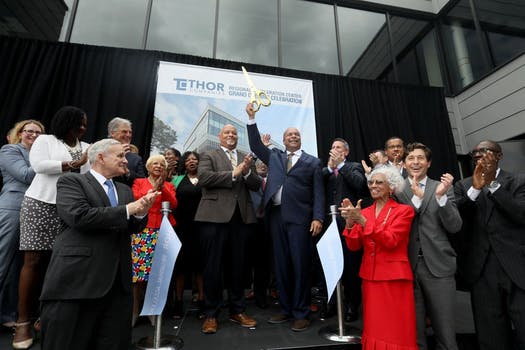
A brief History of
THOR construction Co.
Established in 1980, THOR had previously been involved in
some of the Twin Cities biggest construction projects, such as the U.S. Bank
Stadium and the University of Minnesota’s TCF Bank Stadium, among others. THOR
though most of its business came from work it did out of state.
In early 2017, THOR was selected as a key partner in the redevelopment
of the Upper Harbor Terminal, after the Minneapolis City Council and the
Minneapolis Park and Recreation Board approved, the plans to build hundreds of
units of housing; thousands of square feet for manufacturing, offices, shopping
and restaurants; a public park; and most notably, a performance venue in the
form of a 8,000-10,000 seat outdoor amphitheater.
Over the last 40 years THOR managed to keep its head above
water, while other contractors quickly sank. THOR also was one of the most diverse
construction companies in the industry with an active grassroots recruitment
effort that helped them tap into the black community to hire workers.

Through hard work and dedication THOR Construction evolved
into one of the largest black-owned construction companies in the nation. Along
with their office in Minneapolis, the contractor increased its national
footprint as a full-service self-performing concrete contractor by opening an
office in Las Vegas.
Key THOR self-preforming projects in Las Vegas included
T-Mobile Arena ($375 million), and Mandalay Bay ($66 million).
THOR’s portfolio of self-performing concrete projects also includes
work across a wide spectrum, with a major emphasis on sports facilities and
arenas, along with, hospitality and gaming, mass transit, commercial buildings,
factories, highways, and heavy infrastructure.
The contractor is a part of the Associated General
Contractors, National Association of Minority Contractors, and the U.S. Green
Building Council.
As soaring numbers of construction workers battle opioid addiction,
building trades leaders across the U.S. are launching solutions intended to show
contractors and union members how they can help those who are hooked on opioids.
“We don’t push someone away who gets cancer or diabetes; we
shouldn’t get rid of someone who suffers addiction,” said Thomas Gunning III,
director of labor relations for the Building Trades Employers’ Association.
“It’s a disease of the mind, and we want to help them,” he
said, according to the Boston Globe.
Yet, for decades when it came to marijuana usage, pushing
away and completely ostracizing workers is exactly what contractors and union
have done, and continue to do. So why are contractors forming coalitions to
battle opioid addiction, and trying their hardest to retain those workers that
are addicted.
But, some are arguing that this concerted effort of
retaining and offering resources to opioid addicts is because statistically this
type of drug abuse mostly affects white/Caucasians construction workers.
In recent years, many states in the U.S. have loosened up
their regulation and restriction laws related to cannabis, or marijuana, with
33 states and Washington, D.C., currently allowing it for medical reasons. Ten
of those states and D.C. allow adult recreational use.
Although, for the majority of major U.S. contractors and
labor unions, this new status of marijuana, which used to be an illegal
substance, has not persuaded them to loosen their restrictive hiring practices,
and drug testing for the substances THC & CBD.
In most cases, to align themselves with the wishes of their
clients, many large construction companies have decided that a positive drug
test is a reason not to hire or, under some conditions like an accident, a
reason to terminate employment. Even where it’s legal.
This type of enforcement of anti-drug policy has
historically punished and prevented many black construction workers from
entering the industry, and building lasting careers.
However, as far as opioid abuse is concerned, which the
federal government has described as a “crisis”, and in 2017 accounted for more
than 47,000 deaths, contractors from across America are organizing in an effort
to break down, what they describe as a “stigma” surrounding opioid abuse.
Among other goals, contractors and trade associations are
even going as far as to call for ‘Narcan’ to be available at all job sites to
help prevent opioid overdose deaths.
According to the Boston Globe, Kevin Gill, president of McCusker-Gill Inc., a
sheet-metal contractor that employs 200 workers, said Narcan will be provided
at his company’s fabrication shop.
Gill explained to the Globe, “It’s a very tough trade. Workers
may have been given a painkiller to offset an injury, and before they know it,
they have a full-blown addiction,”
“I want them to be comfortable to come to us to share their
problem and work with us to hopefully come up with a solution,” Gill went on to explain.
Studies show that opioid abuse costs construction companies
billions every year, in missed workdays, healthcare expenses, job turnover and
the costs of recruiting and retraining new employees.
Medical experts note that marijuana is significantly less
addictive and it doesn’t lead to overdoses. A recent study revealed that 93
percent of respondents found marijuana to be a more effective pain treatment
that produced fewer side effects than opioids, and is a less costly treatment
than opioids.
Given the nature of federal law versus state law, it’s hard
to tell if construction employees will ever be allowed to use prescribed
medical marijuana instead of opioids.
Moreover, construction companies under federal contracts are
responsible to adhere to restrict regulation concerning marijuana testing. For
example, if you employ individuals who use a commercial driver’s license you
have to follow the drug testing rules from the Department of Transportation and
the Federal Motor Carrier Safety Administration (FMCSA).
A public beset by potholes, failing bridges and troubled
transit systems overwhelmingly has said in surveys that it supports the $2
Trillion infrastructure investment that President Trump and Senate leader Chuck
Schumer agreed upon last Tuesday, but Congress has yet to come up with a
funding solution.
“We agreed on a number, which was very, very good, $2
trillion for infrastructure,” Schumer said. “Originally we had started a little
lower; even the president was willing to push it up to $2 trillion. And that is
a very good thing.” Schumer told the press after his meeting at the White
House.
“It was a good, positive meeting,” said Peter A. DeFazio,
chairman of the House Transportation and Infrastructure Committee. “The
President spent a good time listening, and then he had things to say on his
own. It was pretty balanced. He responded to points that were made and made
points of his own. “
“I would say that 80 percent of it focused on infrastructure
writ large,” DeFazio said. “We agreed upon a broad figure of $2 trillion of
investment. Probably the largest chunk would go to roads, bridges, transit, but
we’re also going to do waste water, harbors, [and] probably include airports.
There was consensus on the need for universal broad band and some discussion of
a more efficient energy grid to transmit energy over longer distances. There
was some discussion of renewable energy, but no specifics on those.”
"The United States has not come even close to properly
investing in infrastructure for many years ... We have to invest in this
country's future and bring our infrastructure to a level better than it has
ever been before," a statement from
the White House press secretary read.
For Mr. Trump, an infrastructure deal would provide him with a bipartisan achievement he could point to while campaigning. But, Consistently, black activists, residents, and community groups identify displacement as a pressing concern. Anxieties about residential, cultural, and job displacement, are increasingly being caused by changes directly connected to gentrifying forces. These changes stem not just from individual action and market forces but also government intervention.
Gentrification is tied to historical patterns of residential
segregation, followed by the forces of gentrifying revitalization since the 1980s.
Government and public policies such as infrastructure investment have played a
key role in creating these patterns by directing public and private capital in
ways that advantage some and disadvantage other neighborhoods.
A recent study of Los Angeles and San Francisco analyzes
gentrification and displacement separately, finding that transit development’s
plays a significant role in gentrification. Although the vast majority of reporting
on transit infrastructure investment focus on the impacts of transit on real
estate value, a number of scholars are beginning to investigate the
relationship between transit investments and gentrification, with an implied
relationship to residential displacement.
Moreover, with transportation projects, and gentrification being a key issues in cities like Oakland, Los Angeles, and Philadelphia, black workers in these cities are also complaining about increased racial discrimination in the construction industry.
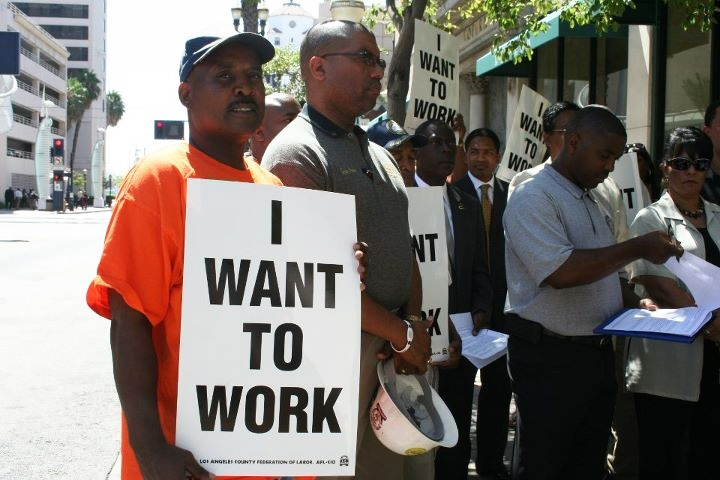
In Philadelphia for example, black members of Local 542, say
they have heard white supervisors throw around phrases like “worthless nigger”
on job sites, just like in the Old South. And in 2017, a black operator found a noose hanging from his crane while working at a
local power plant. In May, during the biannual general membership meeting of
Local 542, one black member seized the mic and proclaimed that he would no
longer tolerate racial epithets from the rank-and-file members of the union. “I
am not a monkey,” he said in part, according to those in attendance.
But truly how will this new infrastructure plan benefit black tradesmen and women, as well as black contractors? $2 Trillion is a huge sum of money, but will this infrastructure bill create true value for the black community in the form of well-paying jobs, and investment opportunities, is unclear given the historically racist reputation of the construction industry.
It's unclear whether or how Republicans and Democrats will
be able to find common ground on a funding source for a large infrastructure
package, something that has eluded them for years.
Despite the US context of growing income segregation, residential
and commercial gentrification is occurring in lower-income neighborhoods,
transforming the meaning of the neighborhood. And, although the displacement
discussion in the United States began with the role of the public sector and
now has returned to the same focus, it will be necessary for the black
community to overcome methodological shortcomings of disunity, and to come
together under one voice in order to effectively change the political landscape
surrounding government infrastructure investment as it relates to high-paying, skilled jobs, and gentrification.
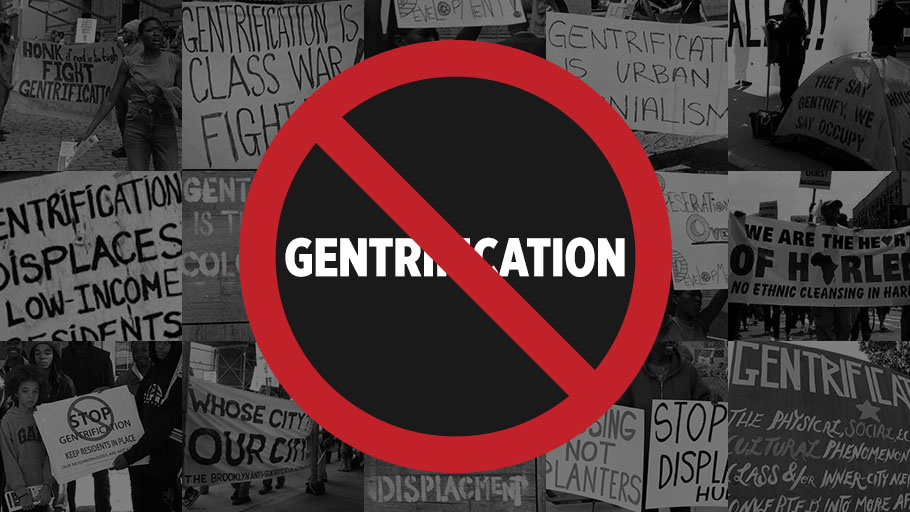
On April 17th, the city of Los Angeles City approved a
historic Civil and Human Rights Ordinance (CF 18-0086). The ordinance co-authored
by Council President Herb J. Wesson and Council member Gil Cedillo and seconded
by other Council members, is designed to create protections for workers by overseeing
discrimination cases that occur within the city.
This is the second time in L.A.’s history that a civil
rights ordinance was up for vote by the City Council. The city’s first civil
rights ordinance was originally presented in 1955, but was voted down due in
part to the racist climate of that era.
The new ordinance gives black workers and other workers in
the city limits the ability to submit a complaint and have their issues of
injustice heard at the local level. This ordinance, 1.) Prohibits discrimination, prejudice,
intolerance and bigotry that results in denial of equal treatment of any
individual; 2.) Provides remedies accessible to complainants; 3.) Creates the
City of Los Angeles Civil and Human Rights Commission and other supporting unit
to investigate and enforce violations of civil & human rights.
On the steps of City Hall, L.A. City Council President Herb
Wesson, who co-authored the ordinance, addressed at crowd workers and members
of the Los Angeles Black Workers Centers, who celebrated the passing of the ordinance,
they helped to push, as a victory, following the vote.
"Today's vote brings us one step closer to making sure
our city's rich diversity is represented in the workplace. With this vote, we
are prioritizing vital protections for L.A.'s Black and Brown workers,
including women, immigrants, those who identify as LGBTQ, and Muslims.
Employment should be based on a person's merit, experience, and character, not
the color of their skin, where they're from, or who they love. A big thank you
to the Los Angeles Black Worker Center for their work in getting us to this
point."
As a diverse metropolis, with over 400,000 black people living
in the City of Los Angeles, the city has a duty to protect and promote public
health and safety within its boundaries and to protect its residents against
discrimination, threats and retaliation based on a real or perceived status.
The unemployment rate for Black workers in Los Angeles is 16%,
three times the national average, and yet nearly 70 percent of the state’s
workforce discrimination claims are based on race and disability. Such
discriminatory and prejudicial practices pose a substantial threat to the
health, safety and welfare of the community.
The activism of African American construction contractors in
an important, and often overlooked, piece of the broader history of racial
exclusion in the national construction industry. Black contractors seldom receive consideration
as agents of historic change. The study of black/African-American contractors
provides a distinct grassroots perspective from which to view the relationship
between black business and black labor.
African-American contractors’ historic link to black workers
was a central component in the late 1960’s and 1970’s. By the time that civil
rights activists launched mass protest that shut down construction sites in the
1960’s, black tradesmen and contractors in the San Francisco Bay area had spent roughly two
decades trying to compel the lily-white building trades unions to open their
doors to black workers.
Although the history of racial discrimination and exclusion
in organized labor unions dates back to the nineteenth century, after slavery, in places such as the Bay Area the issue became particularly
apparent in the 1940’s after World War II, with the massive wartime migration
of black Americans from the South & Midwest.
Many of the tens of
thousands of black Americans who migrated to the Bay Area in the decades after
WWII were experienced and skilled tradesmen, such as plumbers, pipe fitters,
electricians, painters, and plasterers who sought work in the booming shipyards
and expanding commercial and residential construction markets. But like other
black tradesmen that arrived in other union strongholds such as New York,
Chicago, Pittsburg, and Seattle during and after WWII, these tradesmen found
themselves subjugated to severe racial discrimination, and restrictive labor
unions.
When confronted with union discrimination, black tradesmen
responded in a variety of ways: some looked for work in other industries, or
accepted lower-paying and less-skilled construction work as laborers; others
sought assistance from civil rights organization, and government agencies, but
these entities did not produce substantial and permanent gains for black
tradesmen. However, skilled black tradesmen could also exercise another option –
contracting.
The decision to become contractors grew out of constant
severe discrimination, and economic necessity. By setting up shop for themselves,
black tradesmen who took the state contractors’ licensing exam improved their
chances of avoiding union discrimination and gaining a greater degree of
control over their work lives.
As black contractors bettered their chances to earn a living
in the construction industry, they also created important roles for themselves
as employers and mentors for black tradesmen who were curtailed by labor unions
in their search for work and training opportunities. Through their close
relationships with black tradesmen, black contractors established an important
link to the growing Bay Area black communities.
As small, new contractors, starting out for the first time post World War II in the vast construction industry, black contractors were mostly sole
proprietorship's , and the owner was usually his own best worker. The majority
of black contractors in this period built one or two houses a year and spent
most of their time performing repairs and ‘patch work.’
In fact, according to a 1968 estimate of the Small Business
Administration (SBA), only 8,000 of America’s approximately 870,000
construction firms were black or minority-owned. The disparity between black
and white contractors widened throughout the 1960’s as, in the Bay Area and
across the United States, residential construction begin to stagnant, while
large-scale, especially government-financed construction expanded.
Moreover, in 1969 the presidential Cabinet on Construction
predicted that the “United States will put in place in the next 30 years as much construction as there has been from the founding of the Republic to now.” Yet black contractors stood to gain little
from the construction boom.
According to a 1967 report, for instance, black/minority
contractors accounted for less than $500 million of the $80 billion U.S.
construction industry. This disparity was evident in the Bay Area, where by
1968 not one of the approximately 125 black contractors in the region was working
on a large publicly financed job.
Joseph Dedro
enters the industry
In cities across the United States, a small number of black
contractors and business leaders sought to make changes for the better of blacks in the
construction industry. Chief among them was Joseph Debro. Born in Jackson,
Mississippi, Debro came to the Bay Area with his parents after WWII, and became
a contractor.
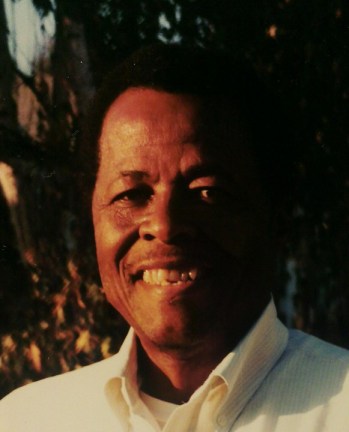
Debro entered into construction with advanced university training,
after obtaining an undergraduate degree in engineering and a master’s degree in
biochemistry from the University of California. Debro became interested in
large-scale construction projects while working as an engineer on the
construction of Interstate 580 in the East Bay during the 1950’s. In the years
following, he developed a keen interest in the problems confronting black
contractors and emerged as one of the leading advocates for black contractors.
Beginning in the 1960s, Debro focused his work on overcoming
the four major obstacles that prevented black contractors from expanding their
companies and obtaining lucrative government contracts: Lack of Skilled Labor,
Lack of Technical Management Skills, Lack of Capital, and Bonding Requirements.
The lack of skilled workers for instance, was a direct result of the building
trades unions, which controlled the primary avenue to apprenticeship training.
But, the fourth obstacle – bonding requirements – proved the most troublesome
for black contractors to overcome.
Because of their historical lack of capital and technical
training, black contractors claimed that the bonding requirements created a
vicious cycle in which most black contractors lacked experience, capital, and
managerial capabilities required to obtain the bonds they needed to quality for
various types of projects that would give them the experience needed to qualify.
But, Surety companies that issued bonds, claimed that they also
considered other factors when deciding whether to issue a bond or not, such as
the “three C’s”: Character, Capital, and Capacity. Although,in a unpublished 1968
memorandum, the American Insurance Association stated that it believed “that it
will serve NO USEFUL PURPOSE, economic or sociological, for surety companies to
issue contract bonds indiscriminately to all applicants, qualified or not.”
Black contractors considered such practices as examples of
racial discrimination and frequently protested that the industry perpetuated a
double standard. As a result, Debro and other black contractors testified to congress that
surety companies denied bonds to qualified black contactors, but these charges
of overt discrimination were often difficult to prove because the majority of
black contractors could not meet the capital requirements of most bonding
companies anyways.
Debro believed something needed to change, and that the free
market could not solve the bonding problems, nor the other obstacles that
limited black contractor’s opportunities. He felt that “all these problems are
aggravated by the inaction of city leaders (working) in the unions, government, private
business, and universities who should be devoting their time to mobilizing
resources on a local level to cope with the exclusion of minorities from all
phases of the construction industry.”
However, before black contractors could expect to receive external
assistance, Debro felt that they needed to organize themselves on a larger
scale.
Joe meets Ray
In the Bay Area, protesters begin to target the construction
of the Bay Area Rapid Transit System (BART), a billion-dollar project that was
scheduled to take five years to complete. Much of BART’s construction was
located in some of the poorest neighborhoods in Oakland and San Francisco, and
local residents made it clear that they would not stand by idly while white
construction crews performed work and earned middle-class wages.
And it was in that tumultuous atmosphere that a black
electrical contractor named Raymon Dones walked into Joseph Debro’s office in
1966. Although Ray was not seeking a contract on the BART project, he hoped
that Joe Debro, who was at the time, serving as the executive director of the Oakland Small
Business Development Center (OSBDC), could help him obtain a loan so that he
could bid on other government projects.
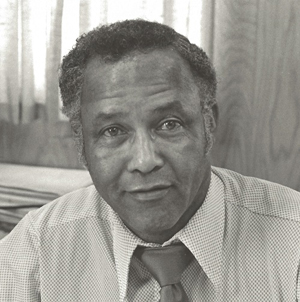
Born in Marshall, Texas, Raymon Dones moved to the Bay Area in
1950, and in 1953 he established Dones Electric (which later became Aladdin
Electric) in Berkley, CA. Like many
other black contractors in the Bay Area during this period, Aladdin Electric
procured steady employment on small residential buildings, and by the mid-1960’s
he had a workforce of six full-time electricians – all of whom were black.
Yet when the residential construction market slowed down, Ray was unable to obtain surety bonds to bid on lucrative government –financed
construction projects, and as a result he had to lay off two of his
electricians. Hoping to avoid further cutbacks and looking to expand his
company, he visited Joe Debro at the OSBDC.
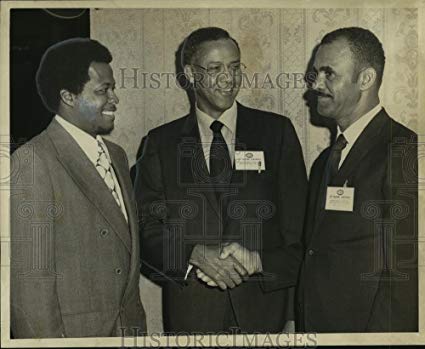
Ray Dones and Joe Debro immediately hit it off , and instead of
arranging a loan they discussed forming an organization that could assist black
contractors in making the transition from small residential construction to
larger public-sector projects. Shortly thereafter,
Dones and Debro formed the General and Specialty Contractors Association
(GSCA), which was among the first black contractor associations in the United
States.
The founders of the GSCA hoped their organization would appeal to small-scale contractors by offering a variety of programs designed to provide the managerial and technical assistance needed to compete with more established firms on large and publicly financed projects.
In its first three
years, the GSCA developed programs to provide information to black contractors
about publicly funded contracts, and assisted inexperienced members with
preparing estimates, and business procedures on jobs in progress, as well as mediated in labor disputes.
And in 1968, six GSCA members pooled their resources to form
Trans-Bay Engineering and Builders, Inc., a general contracting firm that they
hoped could compete with the larger white-owned contracting companies in the
Bay Area.
Creating
opportunities & training the Bay
The GSCA also placed emphasis on training black workers for
the building trades. Because of their need for skilled tradesmen, the GSCA
contractors made training black and other races of workers an important part of
their mission. GSCA contractors stressed
that the historical link between black contractors and the unions’ history of
discrimination caused young blacks to avoid union-administered apprenticeship
programs. GSCA leaders insisted, most construction workers learned trade skills
through on-the-job training - something black workers acquired while working
for black contractors.
Black contractors sought a model for integrating
construction training into the black community, which would at the same time eliminate
the barriers that limited their access to jobs. By the summer of 1967, the GSCA
and the OSBDC had drafted a ‘community action program’ for Oakland that
proposed the of use black contractors as the primary vehicle for training black
workers.
The plan called for
an “On-the-job Training Credit Bank” that would provide training and employment
for approximately six-hundred workers while creating an economically viable
group of building contractors who would be able to carry-on the training of black
workers, and assist contractors with increaing their business skills.
After the program was rejected financing by the federal
government. Dones and Debro eventually found proper funding, from private
philanthropies, such as the Ford Foundation, which provided a 3-year, $300,000 grant
in 1968, so that the Credit Bank could help cover the costs of training black
construction workers, while simultaneously increasing the bond capacity of black
contractors.
The Oakland Bonding Assistance Program, as it was named, produced immediate results. Within a few months of operation, the program made 35 bond-related advances totaling $287,544, to black contractors to secure bonds needed to bid on government projects.
Trans-Bay Engineers and Builders was the
program’s biggest client. It was able to obtain an interest-free $50,000 loan
from the fund to secure a bond on the construction of the West Oakland Health
Center, a contract that the company would have otherwise lost because the surety
company had cancelled company's bond at the eleventh hour.
The GSCA also formed a program called PREP (Property
Rehabilitation Employment Project), and formed a cooperation with the Alameda County
Building and Construction Trade Council, which was eventually financed with grants
for the Department of Labor and the Ford Foundation. One of PREP's mission was to help black
tradesmen with previous construction experience attain journeyman status. And,
in 1969 PREP provided construction training to hundreds of black youth who were unable to
get into union apprenticeship programs.
The success of the these programs helped GSCA become an integral component of the Oakland
Redevelopment Agency’s (ORA) attempts to maximize black participation in its
West Oakland projects. GSCA helped black and other races of contractors secure “turnkey”
agreements with the Oakland Housing Authority.
This level of participation had a direct impact on black
employment on redevelopment projects. And in 1970, Joe Debro reported that 200 new
jobs had been generated and black tradesmen work hours and wages roughly doubled,
and “generated more non-white union journeymen in the in the high-wage crafts
than in the entire history of the local hiring-hall process.”
The GSCA’s pilot project in the Bay Area became a model for
programs across the Unuted States, and helped Bay Area contractors take a lead role in the
founding a national black contractors association to build upon their success.
Based on early returns, and success in Oakland, the Ford Foundation helped
launch similar programs in New York, Boston, and Cleveland.
By organizing themselves into collective associations and
advancing their program in Oakland, Joe Dedro and Ray Dones’ programs and
policies had gone on to effect the national agendas, and have in recent years inspired black
contractors and other minority contractors to create organizations that
successfully address discrimination in the historically racist construction
industry.
JOE AND RAY'S LASTING LEGACIES...

After retirement, Joe Debro never ceased to be active in his community and began writing for several community newspapers, including the San Francisco Bay View, a national Black newspaper; the East Bay Express; and the Oakland Post.
He continued to mentor and advocate for young business people and contractors, trying to break down the barriers of racial exclusion in trade unions and government contracting.
Joe Debro struggled to insure that all of his children
acquired an education, and all three of his sons not only graduated college,
but attained Master’s degrees. The middle son, Karl, earned his doctorate a
year before his father’s death.

AAs for Ray Dones, during his 20 years of business, Ray was ranked in the Top-6 black construction contractors in the United States, completing over $200 million worth of construction contracts. He made history in 1970 when he partnered the company he helped create, Tran-Bay, with Turner Construction to create the first joint venture project between a major firm and a minority builder.
In 1999, Engineering New-Record magazine named Raymon Dones as one of the most influential people in the construction industry
over a 125-years period.
Ray continued his activism in the community throughout his lifetime. He served on the National Urban League, UC Regents of Advisors, the Oakland Chamber of Commerce, and as a volunteer with the Museum of African-American Technology (MAAT)
BOTH MEN WILL TRULY BE MISSED BUT THEIR LEGACIES AND CONTRIBUTIONS TO THE BETTERMENT OF BLACK CONTRACTORS & BLACK TRADESMEN WILL LIVE ON AND NEVER BE FORGOTTEN!

